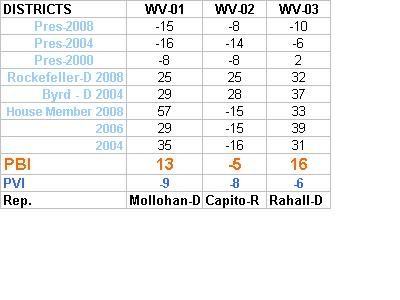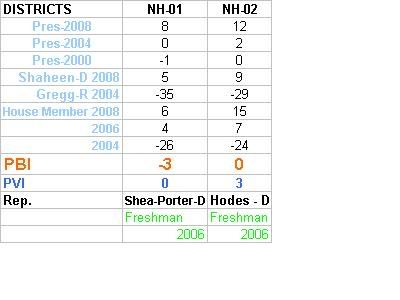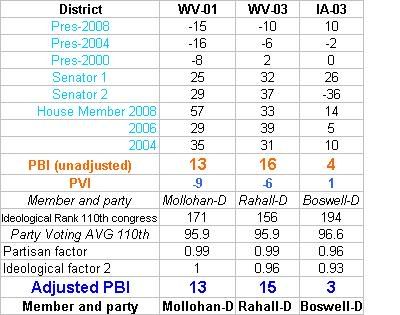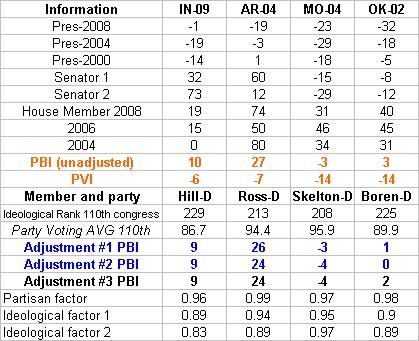PBI or Party Brand Index is a concept I developed (with some much appreciated help from pl515) as a replacement for PVI. PVI (Partisan Voting Index), which is measured by averaging the percentage of the vote from the last two presidential elections in each house district, and comparing it to the nation as a whole, is a useful shorthand for understanding the liberal v. conservative dynamics of a district. But PVI in my opinion it falls short in a number of areas. First it doesn’t explain states like Arkansas or West Virginia. These states have districts who’s PVIs indicates a Democrat shouldn’t win, yet Democrats (outside of the presidency) win quite handily. Secondly why is this the case in Arkansas but not Oklahoma with similar PVI rated districts?
Lastly PVI can miss trends as it takes 4 years to readjust. The purpose of Party Brand Index is to give a better idea of how a candidate does not relative to how the presidential candidate did, but compared to how their generic PARTY should be expected to perform. I’ve tackled IN, NC, CO, VA, MO, OK, AR, now I will look at the swing states of West Virginia and New Hampshire.
First like always I would like to post the data, then I will offer some analysis. My basic pattern is to work my way “out” from the “Purple States” to the more Blue and Red ones. Once in a while I like to skip my normal pattern of working out from purple states. I’m often curious on how my model would work in states like that are deeply blue at the local level, but deeply red at the presidential level. I will offer a refresher on them later. But first let’s examine the swings state of New Hampshire and the “split” state of West Virginia.
WEST VIRGINIA

NEW HAMPSHIRE

Although PBI shows some level of pessimism for Carol Shea-Porter in the NH 1st, the trend in her district is truly astounding. From -26% to a +6% Democratic in 2 election cycles. Also during that time NH has seen a 5% rise in the percentage of the electorate that calls itself liberal (conservatives fell 2%) and the party split went from 32:25 Republican to 29:27 Democrat. Although this district isn’t completely safe the trend is good for Team Blue. She is still the top GOP target in the New England.
After I come across a few “conservative” Democrats, I run a “correction” factor to account for them being Blue dogs. The general idea is that the distance they are able to maintain from the national party may help them win over voters who are more reluctant to vote for Democrats. Interestingly enough both West Virginian Democratic Reps despite coming from a Red, Socially conservative state are not members of the Blue Dog caucus. I never the less ran there data to see how my model would respond. I actually was surprised where they fell on the partisan and ideological scale. As I explained a few diaries ago I will use ADJUSTMENT FACTOR 2 in all subsequent corrections.
THREE BLUE DOGS

As a recap, here is the first “batch” of Blue Dogs that I examined correcting for partisanship and ideology. Notice the differences in both partisanship and ideology between the West Virginian congressman, and the AK and OK ones. Nate Silver has been hopeful that Obama could recapture West Virgina for the Democrats. This data shows West Virgina although often lumped in with the other highland/Appalachia region that turned most heavily against Obama is quite a bit more progressive then other states in that area. If they become comfortable with Obama’s race he could maybe overcome the recent red-tide there.
FOUR BLUE DOGS

As a reminder ranking a members ideology is a somewhat subjective decision. Potentially what’s one person “liberal” position, is another person “conservative” ones, remember the wingers developed a model that ranked the Sen. Obama as more liberal than Bernie Sanders or Russ Feingold. But partisanship, how often a member votes with their party is an absolute number. A Democrat who represents a “republican district” would be expected to “break with their party” on votes that don’t reflect their districts values.
I couldn’t find a website that ranks all the districts based on their PVI (I only could find list of them by state not rank, help please anyone), therefor I substituted a PVI ranking with where each member ranked in the Democratic caucus. In the 110th Congress the average Democrat had an ideological ranking of 170 (by the way this is a result of several members being tied, this is the medium not the midpoint). The average of members towards the center was 191, former Daily Kos celeb Ciro Rodriguez fell at exactly 191. The average of members towards the liberal side was 121, which falls between Rep. Larson of Conn. and Rep. Eshoo of CA. As or partisanship in the 110th Congress the average Democrat voted with their party 92.3% of the time.
As a clarification in Adjustment #1, I used a deviation factor based on how far each member was from the center of the Democratic caucus. Adjustment #2 was based on how far each member was from outside the standard deviation of the caucus. In Adjustment #3 I removed the partisanship factor to see what effect it would have. As I explained a few diaries ago I will use ADJUSTMENT FACTOR 2 in all subsequent corrections.
Because there are “only” 50 states (as opposed to evaluating 435 house members), I will at a later date have all the states ranked by PVI so I can adjust the Senator’s rankings. I developed Senate factors for the four states the four blue dogs came from. In the interest of full disclosure, my source for ideological rankings is Voteview, and for partisanship it was the Washington Post. This is still a work in progress, I’m making adjustments, and continuing to crunch numbers for more states. I also will use the adjustment factor on a liberal member of congress to see what effect that will have.
One thought on “PBI (Party Brand Index) Part 6: West Virginia & New Hampshire”
Comments are closed.